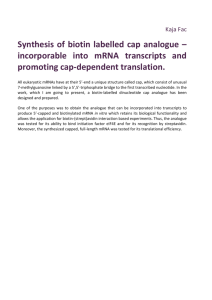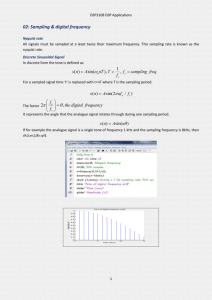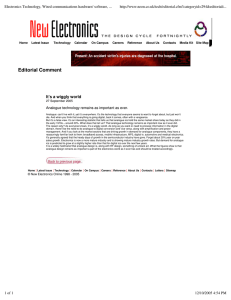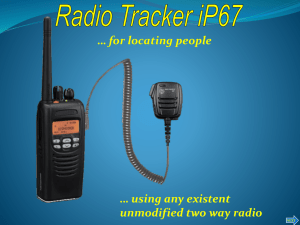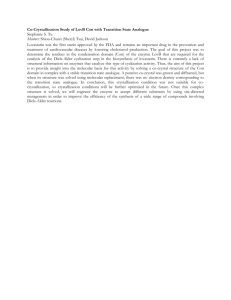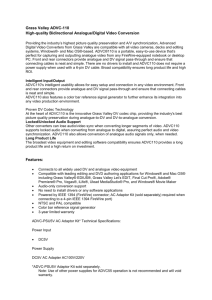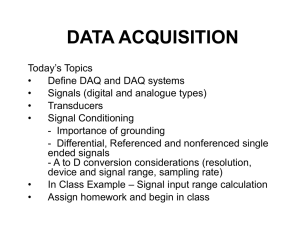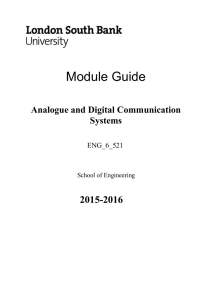Document
advertisement
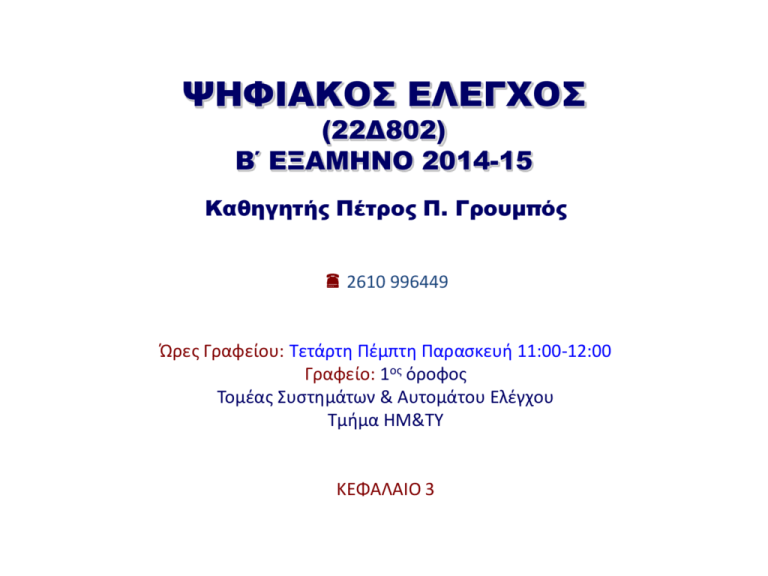
ΨΗΦΙΑΚΟΣ ΕΛΕΓΧΟΣ
(22Δ802)
Β΄ ΕΞΑΜΗΝΟ 2014-15
Καθηγητής Πέτρος Π. Γρουμπός
2610 996449
Ώρες Γραφείου: Τετάρτη Πέμπτη Παρασκευή 11:00-12:00
Γραφείο: 1ος όροφος
Τομέας Συστημάτων & Αυτομάτου Ελέγχου
Τμήμα ΗΜ&ΤΥ
ΚΕΦΑΛΑΙΟ 3
Models for Sampled Data
Systems
Motivation
Up to this point , we have assumed that the control
systems we have studied operate in continuous
time and that the control law is implemented in
analogue fashion. Certainly in the early days of
control, all control systems were implemented via
some form of analogue equipment. Typically
controllers were implemented using one of the
following formats:– hydraulic
– pneumatic
– analogue electronic
However, in recent times, almost all analogue
controllers have been replaced by some form of
computer control.
This is a very natural move since control can be
conceived as the process of making computations
based on past observations of a system’s behaviour
so as to decide how one should change the
manipulated variables to cause the system to
respond in a desirable fashion.
The most natural way to make these computations
is via some form of computer.
A huge array of control orientated computers are
available in the market place.
A typical configuration includes:
– some form of central processing unit (to make the necessary
computations)
– analogue to digital converters (to read the analogue process
signals into the computer).
(We call this the process of SAMPLING)
– digital to analogue converters (to take the desired control
signals out of the computer and present them in a form
whereby they can be applied back onto the physical process).
(We call this the process of SIGNAL RECONSTRUCTION)
Types of Control Orientated Computer (1/2)
Depending upon the application, one could use
many different forms of control computer.
Typical control orientated computers are:
DCS (Distributed Control System) These are distributed
computer components aimed at controlling a large plant.
PLC (Programmable Logic Controller) These are special
purpose control computers aimed at simple control tasks especially those having many on-off type functions.
PC (Personal Computer) There is an increasing trend to
simply use standard PC’s for control. They offer many
advantages including minimal cost, flexibility and familiarity
to users.
Types of Control Orientated Computer
(2/2)
Embedded Controller. In special purpose applications, it is quite
common to use special computer hardware to execute the control
algorithm. Indeed, the reader will be aware that many commonly
used appliances (CD players, automobiles, motorbikes, etc.) contain
special microprocessors which enable various control functions.
Wi-Fi Controller(s). wireless controller, provides wireless
performance of all mobile devices, offers limited hotspot
coverage, controls subsystems from distance and more.
Others
First Approach to Digital Control(DC) (1/2)
A simple (engineering) approach to digital control
is to sample quickly and then to make some
reasonable approximation to the derivatives of the
digital data. For example, we could approximate
the derivative of an analogue signal, y(t), as
follows:
y(t ) y(t )
d
dt
y(t )
where is the sampling period.
The remainder of the design might then proceed
exactly as for continuous time signals and systems
using the continuous model.
First Approach to Digital Control(DC) (2/2)
Actually, the above strategy turned out to be quite
good in the early years of DC and it is certainly very
commonly used in theory today and in practice.
However, there are some unexpected traps for the
unwary. These traps have lead to negative
experiences for people naively trying to do digital
control by simply mimicking analogue methods.
Thus it is important to know when such simple
strategies make sense and what can go wrong. We
will illustrate by a simple example below.
D.C. Servo Motor Control
We consider the control of a d.c. servo system
via a computer. This is a very simple example.
Yet we will show that this simple example can
(when it is fully understood) actually illustrate
almost an entire course on control.
A photo of a typical d.c. servo system is shown
on the next slide.
Photo of Servo Laboratory System
with Digital Control via a PC
The set-up for digital control of this system is
shown schematically below:
The objective is to cause the output shaft position, y(t), to follow a given
reference signal, y*(t).
Modelling
Since the control computations will be done
inside the computer, it seems reasonable to first
find a model relating the sampled output,
{y(k); k = 0, 1, … } to the sampled input signals
generated by the computer, which we denote by
{u(k), k = 0, 1, … }. (Here is the sample
period).
We can see that the output at time k can be
modelled as a linear function of past outputs
and past controls. (We ask that the reader
accept this for the moment).
Thus the (discrete time) model for the servo
takes the form:
y k 1 a1 y k a 0 y k 1 b1 u k b0 u k 1 .
A Prototype Control Law
Conceptually, we want y k 1 to go to the desired value
y*. This suggests that we could simply set the right hand
side of the equation on the previous slide equal to y*.
Doing this we see that u(k) becomes a function of y(k)
(as well as y k 1 and u k 1 . At first glance this looks
reasonable but on reflection we have left no time to make
the necessary calculations. Thus, it would be better if we
could reorganize the control law so that u(k) becomes a
function of y k 1
Actually this can be achieved by changing the model slightly
as we show on the next slide.
Model Development
Substituting the model into itself to yield:
y k 1 a 1 y ( k ) a 0 y k 1
b1 u k b0 u k 1
a 1 a 1 y k 1 a 0 y k 2
b1 u k 1 b0 u k 2
a 0 y k 1 b1 u k b0 u k 1
We see that y k 1 takes the following form:
y k 1 1 y k 1 2 y k 2
1 u k 2 u k 1 3 u k 2
where 1 a12 a 0 etc.
Actually, 1, 2, 1, 2, 3, can be estimated from
the physical system and depends on Δ. (We will
not go in to details here). However, for the
system shown earlier the values turn out to be as
follows for = 0.05 seconds:
1 = 0.03554
2 = 0.03077
1 = 1
2 = -1.648
3 = 0.6483
A Modified Prototype Control Law
Now we want the output to go to the reference y*.
Recall we have the model:
y k 1 1 y k 1 2 y k 2
1 u k 2 u k 1 3 u k 2
This suggests that all we need do is set y k 1
equal to the desired set-point y * k 1 and solve
for u(k). The answer is
u k
y * k 1 1 y k 1 2 y k 2 2 u k 3 u k 2
1
Notice that the above control law expresses
the current control u(k) as a function of
– the reference, y * k 1
– past output measurements,y k 1 , y k 2
– past control signals, u k 1 , u k 2
Also notice that 1 sampling interval exists
between the measurement of y k 1 and the
time needed to apply u(k); i.e. we have
specifically allowed time for the computation of
u(k) to be performed after y k 1 is
measured! ( This is very important!!)
Recap
All of this is very plausible so far. We have
obtained a simple digital control law which
k 1
y
to go to the desired value
causes
y * k 1 in one step !
Of course, the real system evolves in continuous
time!!! (engineers may care to note this point
for later consideration).
Simulation Results
To check the above idea, we run a computer
simulation. The results are shown on the next
slide. Here the reference is a square wave.
Notice that, as predicted, the output follows the
reference with a delay of just 2 samples.
Simulation Results with Sampling
Period 0.05 seconds
Experimental results
However, when we try this on a real system, the
results are extremely poor! Indeed, the system
essentially goes unstable (for the first few
seconds).
• Can the engineer guess some of the causes for the
difference between the ideal simulation results and
the very poor real results?
Simulation result showing full
continuous output response
Causes of the Poor Response
It turns out that there are many reasons for the
poor response. Some of these are:
1.
2.
3.
4.
Intersample issues
Input saturation
Noise
Timing jitter
1. Intersample Issues
If we look at the output response at a rate faster
than the control sampling rate then we see that
the actual response is as shown on the next
slide.
Simulation result showing full
continuous output response
This is rather surprising! However, if we think
back to the original question, we only asked that
the sampled output go to the desired reference.
Indeed it has. However, we said nothing about
the intersample response or the other causes!
ΕΔΩ ΥΠΑΡΧΟΥΝ ΕΡΓΑΣΙΕΣ-PROJECTS
Sampled-data systems
Sampled-data systems
ΕΥΧΑΡΙΣΤΩ
ΓΙΑ ΤΗΝ ΠΡΟΣΟΧΗ
.
ΣΑΣ
Καθ.Γρουμπός Π. Πέτρος
groumpos@ece.upatras.gr
